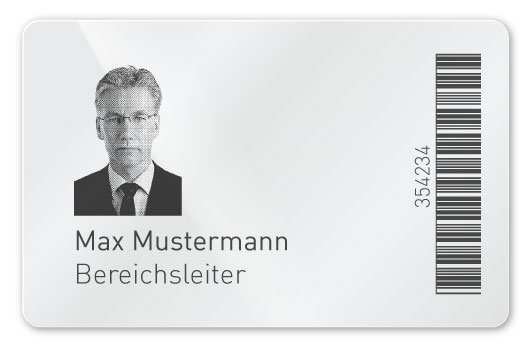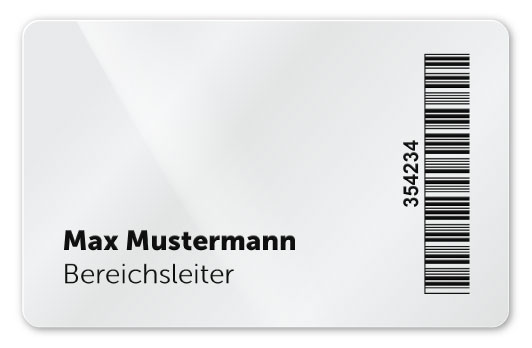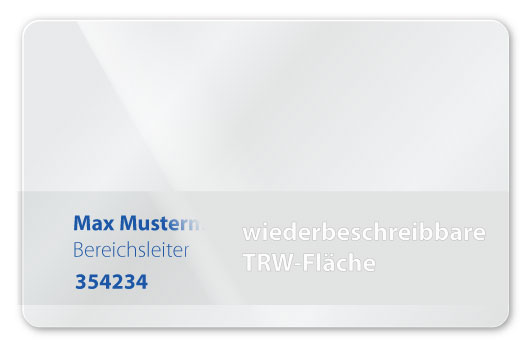Visual Personalisation Methods
Plasticard-ZFT offers nearly all common methods of personalisation, starting from thermo transfer printing right up to digital printing under laminate. Every method has specific properties which are especially suited for certain requirements. You have the option to realise the personalisation on site by yourself with the help of card printers (only TTD, TSD, RTD or TRW) or to use the services offered by Plasticard-ZFT.
Thermo Transfer Printing (TTD)
The thermo transfer printing is one of the most common printing methods for monochrome personalisation tasks. It is the first choice for the consecutive numbers, barcodes or name printing. There are many foil colours on offer (black, white, green, red, blue, gold, silver) and also transparent and holographic protection overlays and scratch-off fields.
- Cost-efficient printing method on laminate
- Monochrome in different colours
- Black is very abrasion resistant, other colours less so (additional protective overlay recommended)
- No full-bleed printing possible
- Good printing quality with up to 300 dpi
- Protective overlay and scratch-off foils available

Thermo Sublimation Printing (TSD)
Der Thermosublimationsdruck kommt dann zum Einsatz, wenn ein fotorealistischer Farbdruck benötigt wird. Für Passfotos und zugehörige Namen und Nummern ist der Thermosublimationsdruck das Standarddruckverfahren. Das normale Farbband umfasst die Grundfarben Cyan, Magenta, Gelb und Schwarz sowie eine transparente Overlayfolie.
- Cost-efficient coloured printing method on laminate
- 4-colour printing (CMYK) + protective overlay
- Good durability with printed overlay
- Requires a very smooth and clean card surface
- No full-bleed printing possible
- Mediocre printing-quality with up to 300 dpi

Re-transfer Printing (RTD)
Der Retransferdruck ist eine weiterentwicklung des Thermosublimationsverfahrens und für höhere Anforderungen geeignet. Für fotorealistische und randabfallende Personalisierungsaufgaben ist der RTD bestens geeignet. Da er auch leichte Unebenheiten in der Kartenoberfläche bedrucken kann, kommt er gerade bei RFID-Karten häufig zum Einsatz. Das normale Farbband umfasst die Grundfarben Cyan, Magenta, Gelb und Schwarz.
- Coloured printing method on laminate
- 4-colour printing (CMYK)
- Good durability with printed overlay
- Prints over small bumps in the card surface (e.g. RFID-chip modules)
- Full-bleed printing possible
- Very good printing quality with up to 600 dpi

Lasering (LSG)
Die Lasergravur von Nummern, Logos oder auch Graustufenbildern kommt vorzugsweise bei der Personalisierung alternativer ID-Medien wie Schlüsselanhängern oder RFID-Armbändern zum Einsatz. Doch auch für Holzkarten und Plastikkarten mit laserfähigem Overlay ist eine Lasergravur möglich. Sie bietet eine besonders hohe Fälschungssicherheit, da eine Lasergravur im Material nicht entfernt werden kann, ohne das Medium zu zerstören.
- Engraved into the material, forgery proof
- Monochrome
- Very good durability, suited for great stress
- Available for wooden cards, plastic cards need a special laser-capable overlay
- Can also realise grey-scale images
- Very good quality with up to 600 dpi

Embossing
Embossing is one of the oldest methods for personalisation and is also used today. The raised characters are known from credit cards whose data has been mechanically pressed via carbon paper. There are only two fonts available – known from credit cards. Additionally, Plasticard-ZFT owns a set of braille characters for embossing Braille Blindenschrift.
- Embossing through the laminate
- Colouring in gold, silver, black and white possible
- Very good durability, suited for great stress
- Only capital letters and digits in two sizes
- Limited character set
- Braille possible
- Only partially suitable for RFID-cards, position of antenna has to be checked in advance

Digital printing sub-surface (under laminate)
Die Personaliseirung unter Laminat wird im Digitaldruck direkt auf dem Druckbogen, zusammen mit dem gesamten Kartenlayout gedruckt. Erst im Anschluss wird aus der Druckfolie ein Kartenkörper hergestellt. Somit liegt die Personalisierung unter dem Kartenoverlay und ist vollständig gegen mechanische Belastungen geschützt. Außerdem bietet dieses Verfahren volle Flexibilität hinsichtlich Design, Schriftarten und Farben. Allerdings sind nur Auflagen bis max. 3000 Stk. wirtschaftlich realisierbar.
- Digital printing under laminate
- Can be realised full-colour and full-bleed
- Very good durability, suited for great stress
- Full flexibility of colours, fonts and design (cartridge and HKS also possible)
- Offset-printing quality up to 1440 dpi
- Suitable for all special formats
- Only small runs of max. 3000 cards

Inkjet Printing
The personalisation with the Inkjet methods happens with solvent ink which soaks into the card material. This printing method is very productive, but only mediocre in quality.
- Liquid ink on laminate
- Monochrome, black
- Good durability, middle stress resilience
- Mediocre to good printing-quality up to 120 dpi
- Suitable for very large runs

Drop-on-Demand (DOD)
The personalisation with the DOD-method happens with liquid ink which is printed onto the card surface and dries with UV-light. The result is a tactile, black personalisation and a high printing quality. The printing method is very productive and thus enables the processing of large runs of cards.
- Liquid ink on laminate, tactile
- Monochrome, black
- Good durability, can only be removed with a tool
- Good to very good printing quality up to 600 dpi
- Suitable for very large runs

TRW Printing (Thermo-Rewrite)
Bei der Personalisierung via TRW-Druck handelt es sich streng genommen nicht um ein Druckverfahren, da keine Farbe auf die Karte übertragen wird. Stattdessen wird eine spezielle Folie auf der Kartenoberfläche mit einem Thermodruckkopf partiell eingefärbt und kann auch wieder gelöscht werden. Die Farbe der Personalisierung ist dabei abhängig von der Folienbeschichtung der Karte. Mehr Informationen finden Sie unter TRW-Cards.
- Dyeing of a special TRW-foil
- Monochrome, black or blue (depending on the card foil)
- Good durability, not heat resistant
- Good printing qualiry up to 300 dpi

You may also be interested in:
picture credits
© Delphotostock – stock.adobe.com
© magneticmcc – stock.adobe.com